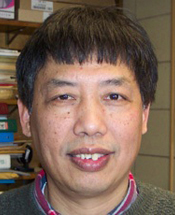|

|
Prof. Cai-Zhuang Wang (王才壮)
Ames Laboratory - US DOE
Department of Physics and Astronomy,
Iowa State University, Ames, USA
Email: wangcz@ameslab.gov |
Abstract: We developed a density functional theory incorporating strongly correlated electronic effects into the kinetic energy functional through Gutzwiller wave functions. We show that within the Gutzwiller approximation, a set of single-particle equations can be obtained from functional derivatives of the energy with respect to the orbitals included in the noninteracting one-particle density matrix with renormalized kinetic and potential operators. This set of equations can be solved self-consistently in a way similar to regular LDA calculations. In our scheme, the variational parameters are the single-particle electron wave functions for the localized and delocalized electrons and the occupancy of the various localized configurations at each atom in the unit cell. Like the LDA, and unlike many other correlated electron calculations available, the formulation is derived from first principles with all Coulomb and exchange-correlation interactions determined self-consistently. There are no adjustable parameters. We believe developments along these lines will be fruitful in extending the successful applications of density functional calculations to systems with important electron correlations.
Research Interests: Condensed matter physics and computational material science. Develop tight-binding potentials and tight-binding molecular dynamics method for materials simulations. Atomistic modeling and simulation study of structural, dynamical and electronic properties as well as phase transformation of condensed matter systems and molecules, including liquid and amorphous materials, defects, surfaces, clusters, and biological molecules. Ab initio calculation and tight-binding molecular dynamics simulation studies of formations, structures, and stabilities of surface-based nanostructures. Structure and dynamics of metallic liquid and glass. Develop genetic algorithm method for crystal structure prediction and materials discovery. Develop methods for first-principles calculation of strongly correlated electron systems
Date&Time: August 14, 2013 (Wednesday), 16:00 - 17:00
Location: 606 Conference Room


